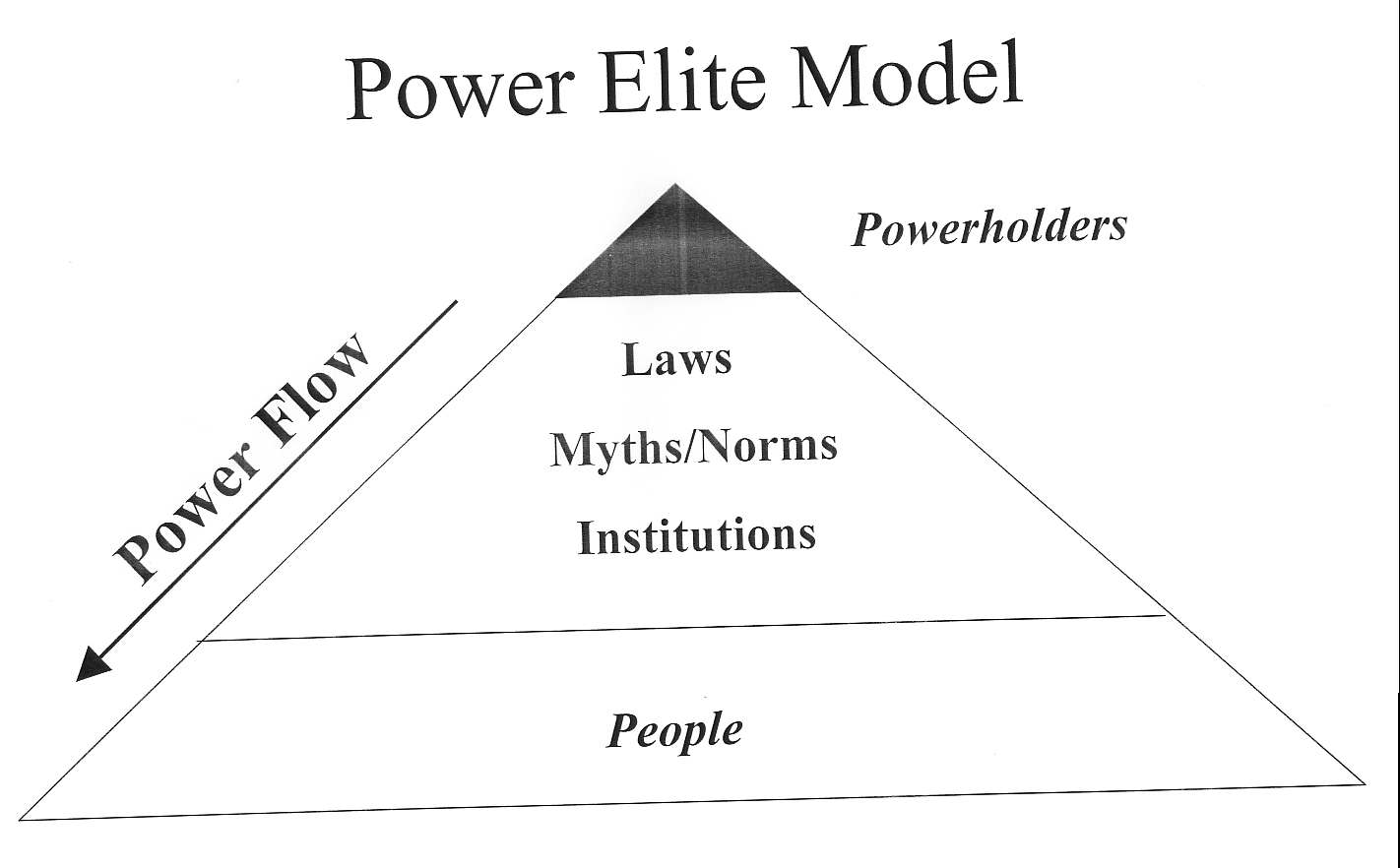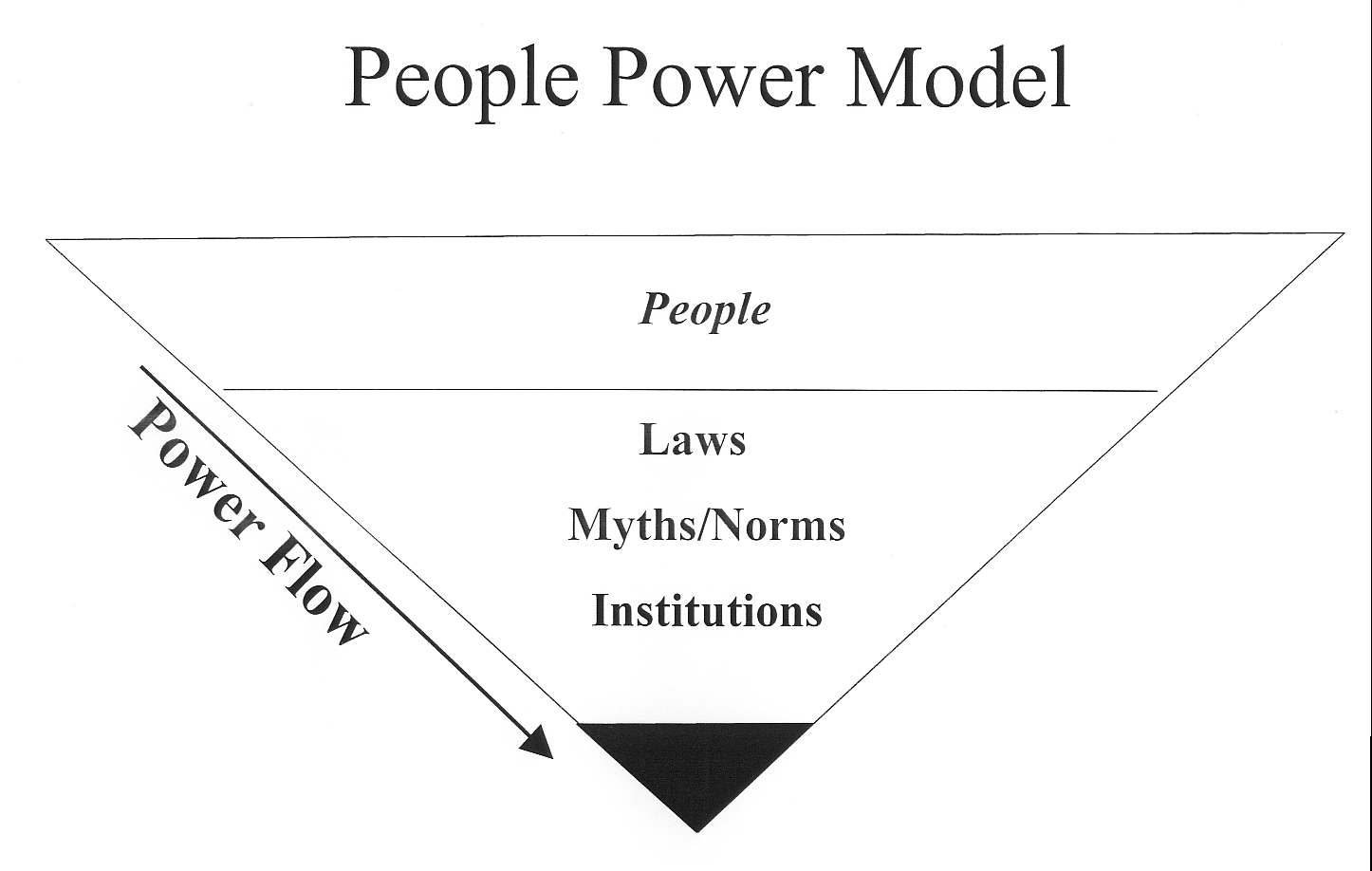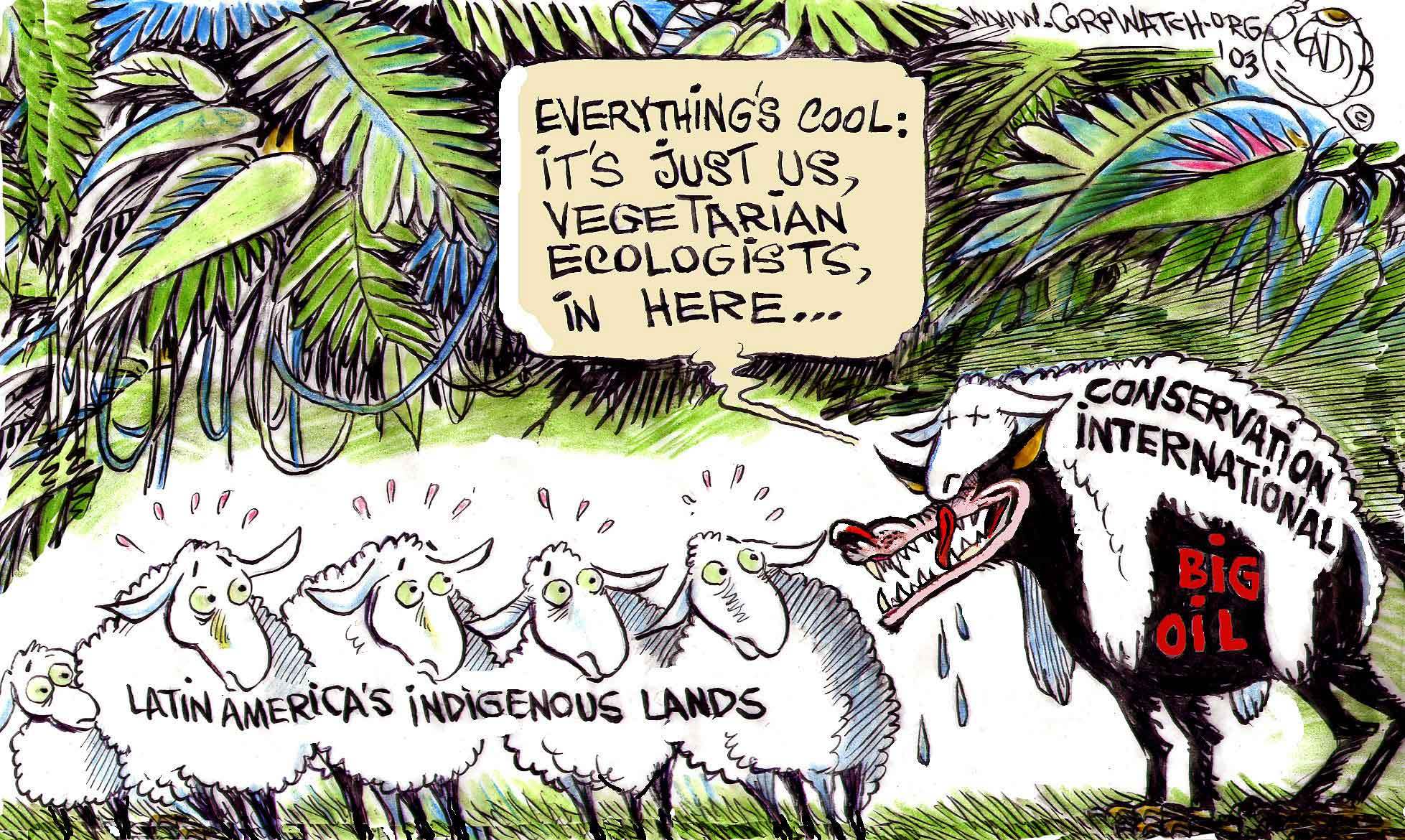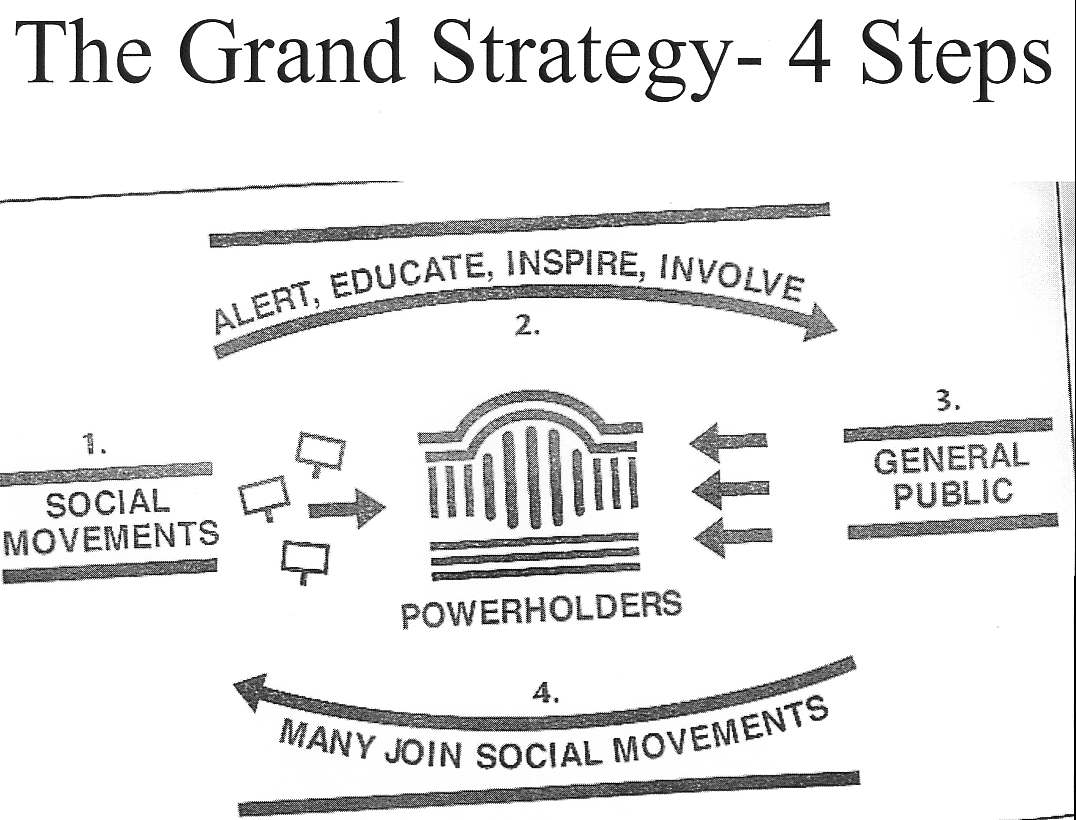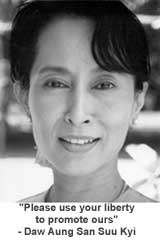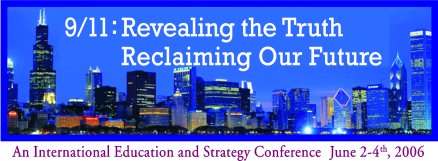
Strategy for the 9/11 Truth Movement
June 3, 2006
Carol Brouillet
www.communitycurrency.org/9-11.html(This is a mixture of text and images, but was designed to be a powerpoint presentation)I'd like to offer some insights, mainly gleaned from the life and work of Bill Moyer, a strategist for Martin Luther King, Jr..

Bill also was the author of- author of Doing Democracy- The MAP Model for Organizing Social Movements.
Judging by his MAP, and the latest Zogby Poll, we are now in Stage 4- The Take Off Stage of the 9-11 Truth Movement.
Why are there social movements? Throughout history, a powerful elite usually exercises influence over a large number of people for their personal benefit and at the expense of the majority. Toynbee noted that the world struggle is between the few vested interests and social justice.
There has always been a struggle between tyrants and people; the people have made some gains, and have had setbacks. Slavery has been formally abolished, although it still exists today. The non-violent social movements of the past two hundred years have advanced the cause of children, women, labor, the environment, and anti-colonial movements. Simultaneously, we have seen a rise in the concentrated economic power of corporations, banks, an elite few over the levers of government, emerging communications, and lethal technologies.
So what is a Social Movement? Collective actions which alert, educate, mobilize the public, sometimes over years and decades, to challenge power-holders and the whole society to redress social problems or grievances, to align with deeply held social values.
Social Movements Further Participatory Democracy.
* They raise expectations that people should participate in the decision making processes in all aspects of public life.
They raise issues and put them on the political agenda *They provide a role for everyone to participate, and engage in the process of solving a problem.
*They are at the center of society; they need to gain the support of the majority of the public, and advance society along the path of human development, moving towards justice, democracy, human rights, security, and freedom.
*They need to be totally nonviolent.Social Movements are an evolutionary force which pushes people to live up to their ideals and values. They enable people to exercise their collective power.
In the classic Power Elite Model power flows downward from those at the top through institutions towards the helpless, people at the bottom of the pyramid. Most people believe in this model. Under this model, change can be achieved only by appealing to the elites, using persuasion.
In the People Power Model, the upside down pyramid places people at the top, and power flows from them through institutions, to powerholders, public servants, at the bottom. This is the radical “of, by and for the people ideal” that helped birth the United States.
The Founding Fathers knew that their winning slogan wouldn’t work so well if they said, “A government of, by, and for “the rich, the white, the male, the propertied few.”
The Powerholder Strategy
The Powerholder Strategy isn’t to broadcast to the public the truth about their beliefs, actions, policies, and programs. They recognize that conditions are generally ripe for social change. They know very well who benefits from the unfair distribution of benefits and costs within the existing system. They consciously must keep their actual policies hidden from the public, because they fear a majority would rebel, if they knew the truth.
The System Relies on Societal Myths and is Threatened by the Exposure of Societal Secrets.
Powerholders use myths, slogans, and rhetoric to sell their policies and programs to the public.
The Societal Secret is that powerholders are generally doing the opposite of the publicly acclaimed myths.
The Myth of Black Voting Rights
Examples include the Myth of Voting Rights for blacks. The big myth was that everyone had voting rights; the societal secret was that Southern Blacks were prevented from voting by all sorts of actual practices and grandfather laws.
The Grand Strategy of all Movements is to-
1st- Convince the public that a problem exists.
The Grand Strategy of all social movements is for the hearts, minds, support of the majority of people, and to get them to exercise the people power that resides within themselves.2nd- Convince the public that policies must be changed.
3rd- Mobilize people into a force that brings about an acceptable solution.
We can see how the perpetrators of 9-11 had a Grand Strategy, too. Their strategy was to terrify people into silence, submission, get more funding for war, a surveillance industry/police state, and to use a BIG LIE to sell a “bogus protection racket” to their victims, to institutionalize under the guise of “National/Homeland Security.” a greater concentration of wealth and power into fewer hands.
Their tools were violence, fear, and the corporate/government/media megaphone.
We have the advantage of being able to expose a giant societal secret that they need to sell their lies, and maintain power.
Our Job is to Expose the Lie We also have to recognize that the deeply held values, symbols, beliefs, sensibilities and traditions that are important to the public are being violated by the power elite. All we need to do is prove to the public that the truth movement, not the powerholders, upholds these values and principles, to motivate and inspire the public to challenge the powerholders and their policies.
We also need to honor, respect and join, in coalition with all the other movements which are part of this grander struggle against the concentrated power of an elite few; this includes all the movements, born out of the struggle for life, liberty, and the pursuit of happiness.
Until social justice is achieved this cycle repeats, and social movements grow more creative, democratic, and powerful.
To win over the public, we need to reframe our issue, expose and prove that the powerholders policies, and programs violate social myths, and deeply shared values. I will map out the details of the eight stages of social movements and activists’ roles in my workshop, and there is an article, with worksheets, also in the new Global Outlook, but here is the gist of the four steps that collectively, we must accomplish-
1) Expose societal secrets and challenge actual policies and programs.
A.) Develop critical analyses, presentations, publications, use all normal public channels, including demonstrations, rallies, marches, when necessary- civil disobedience.
2) Alert, educate, win over, involve, inspire the public to become involved.
3) Mobilize the public, put pressure on powerholders & institutions to change policies & create a new peaceful culture & democratic political conditions.
4) Attract more members of the public to become social activists and to join existing movements or create their own.
Assumptions of the People Power Model #1- A cause of social problems is the concentration of political and economic power in the hands of the few and in institutions that serve them at the expense of the majority of people and planet.
#2- Participatory democracy is the key means to resolving today’s awesome problems, and for establishing a just, peaceful, sustainable world for all. To solve problems requires an informed, empowered, and politicized population that assertively participates in the political/economical process to demand democracy, justice, security, equality, human welfare, peace, environmental sustainability.
#3- Political & economic power ultimately rests with the majority population; the rulers can only rule with the consent/acquiescence of the people.
#4- The most important issue is the struggle between the majority of people and the individual and institutional powerholders to determine whether society will be based on the “power elite” or “people power” model.
#5- This struggle between a belief in “superiority” and a belief in “equality” is going on at all levels of life in the political, economic, and social spheres, and in interpersonal relationships at work, in the community, at home, and within social activism itself.
#6- If non-violent social movements are to successfully address critical issues and create social change, they must be solidly based on participatory democracy, with a clear understanding of power, and how to create people power, that can withstand the onslaught of powerholder attack and counterattack.
Aung San Suu Kyi said-
“It is not power that corrupts, but fear- fear of losing power, and fear of the scourge of those who wield it..”
We Need a Leaderful Movement All Activists are Leaders. The best leaders are often invisible.
5 Wise Leadership Principles include-
1. Challenge the system
These principles actually come from The Leadership Challenge by Jim Kouzes and Barry Posner and have been used to train leaders in all sectors of society.
2. Inspire a Vision
3. Enable Others to Act
4. Model the Way
5. Encourage the HeartWe can’t condemn people because of the hat that they wear- there are radicals working for truth and justice within many organizations and institutes that we oppose. Our hope is to awaken and transform most people into allies.
Ineffective / Effective Ineffective Activists harm and hinder social movements-These are Behaviors/ Pitfalls to consciously avoid -
Acting disempowered, hopeless
Effective Activists nurture and grow social movements, here are some of the characteristics that we should consciously try to practice-
Displaying negative attitude/energy
Acting as an Elitist: Self Identified Vanguard/superior to others
Tactics in isolation from strategy
Pushing “any means necessary”
Being Unrealistic, Utopian, or for merely minor reforms
Acting Passive or Overly Aggressive/Competitive
Adopting Patriarchal/absolute truth/rigid ideology
Putting the “masses” down
Internalizing Dominator ParadigmBehaving Empowered and Hopeful
Displaying a positive attitude and energy
Encouraging People power, participatory processes
Coordinated strategies/tactics
Nonviolence/means=ends
Promoting a realistic vision & social change
Assertive/cooperative win/win
Feminist/relative truths/nurturer/adaptive
Faith in people
Internalizing Peaceful paradigmLast, but not least…

Wars have been fought in the name of religion. At the heart of most religions, is the most valuable lesson that I have learned in my lifetime- “ to forgive, to accept, to love” myself, people and the world.
In activism, when we are working on life and death issues, there is a lot of stress, some danger, and risk. People are doing the work because they care deeply. Most are volunteers; it is important to remember not to be too hard on ourselves and others. It is our genuine love of people and life which gives us our strength, power, and connects us all. Banish fear, laugh, let the journey we are on be our reward, enjoy the wonderful companions that we meet. Together we can do what we cannot do alone.
Link to The Next Stage of the 9/11 Truth Movement article, published by Global Outlook #11, Spring/Summer 2006, with updates.
Return to- 9/11 Revealing the Truth

